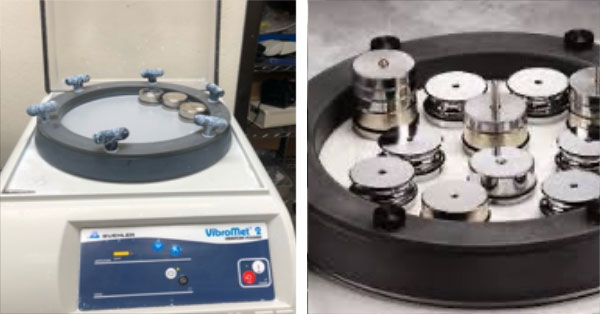Last month we discussed methods of preparing samples for EBSD analysis. As a recap, EBSD requires a highly polished, flat surface for best results. The two most common ways to polish a sample for EBSD are vibratory polishing and ion milling. Last month we focused on ion milling. This month we will discuss the benefits of vibratory polishing.

How is vibratory polishing performed?
Vibratory polishing typically uses a sample mounted in an epoxy “puck.” The sample is delicately polished by the horizontal motion created by the polisher.
The vibratory action produces a very flat surface with minimal surface deformation when compared to the purely mechanical polish from a polishing wheel.
Benefits of Vibratory Polishing
- Vibratory polishers are affordable and relatively easy to set up and master. Typical vibratory polishing times run from an hour to multiple hours and the results can be stunning.
- Vibratory polishers work exceptionally well for soft materials (lead, magnesium, aluminum, and other pure metals) where mechanical polishing can embed diamond or SiC particles into the sample or where an ion mill can cause streaking. We call this scaling where the ion beam cuts a trench in the sample
- Vibratory polishers also work well with samples that are composed of materials of differing hardnesses. Mechanical polishing methods can cause delamination, streaking/smearing, and a non-flat surface. This method will keep the sample surface flat while polishing evenly.
- Most vibratory polishers allow you to run multiple samples at once (normally up to about six) which saves process time and materials ultimately reducing consumable costs.
The best method of sample preparation is dependent on the material to be analyzed, the size of the sample, and how it is mounted.
Prep for EBSD (Electron Backscatter Diffraction) is absolutely critical to get high-quality and accurate data. Consequently, we use both vibratory polishing and ion milling tools in our lab. We find both systems are complementary to each other in a lab like ours where samples and our polishing needs can vary dramatically.
In the JH Lab: Buehler’s Vibromet 2 Vibratory Polisher
The Buehler VibroMet 2 we use in our lab is unlike standard vibratory polishers. The VibroMet 2 oscillates almost entirely horizontally. This helps maximize the length of time the sample is in contact with the polishing cloth. The 7200 cycles per minute horizontal motion produce a very effective polishing action, providing superior results, exceptional flatness, and less deformation.
If you would like a demo of our vibratory polisher or ion milling system or need assistance with your sample preparation process, please use the form on this page to contact us. Or, give us a call at (408) 436-6336.




